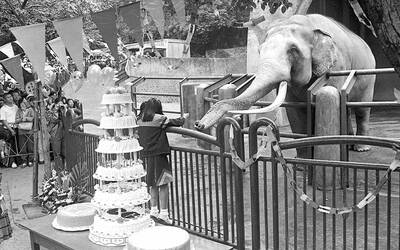His obsession began innocently enough, with the puppies and broken-winged birds every little boy begs to bring home. Over the years, Antoine Yates' taste in animals grew ever more exotic, neighbors said, and his collection came to include reptiles, a monkey or two, and according to one neighbor, even a hyena.
He had a boundless affection for living creatures that he might have picked up from his mother, Martha Yates. Over the years, Martha Yates raised dozens of foster children in her five-bedroom apartment in a public housing high-rise in Harlem, according to one of her foster sons.
But when Yates' most exotic pet -- a tiger that he named Ming -- grew to more than 180kg and let loose a fearsome roar, that happy home disintegrated. Terrified by the beast, Martha Yates packed up the last two of her foster children and moved to a suburb of Philadelphia earlier this year, neighbors said.
Yates, increasingly hard pressed to control the tiger, apparently decamped, too, to a nearby apartment. He continued to feed the beast by throwing raw chickens through a door opened just narrowly enough to keep a paw the size of a lunch plate from swiping through, neighbors said.
Last Saturday, the police moved in, alerted by Yates' curious call in which he claimed to have been bitten by a pit bull. They found Ming and removed the tiger from Apartment 5E after it was shot with tranquilizers darts by a sharpshooter who rappelled down the side of the apartment house. The mission created a swirl of excitement in the neighborhood and left a series of questions for an assortment of officials.
The police are trying to determine where Yates got a tiger cub and how he managed to raise it from cuddly kitten to full adult size in a public housing project for several years.
Officials at the city's Administration for Children's Services said they were trying to determine whether foster children had lived in the apartment while the tiger and other dangerous animals were there. And officials of the New York City Housing Authority were trying to determine how the tiger escaped the notice of workers at the complex.
People who live in the high-rise apartment building in the Drew-Hamilton Houses at 2430 Adam Clayton Powell Boulevard said that the tiger had lived among them for at least three years. His presence, while strange, was widely known, and it did not really alarm anyone, they said.
Jerome Applewhite, 43, who lives on the 18th floor, first encountered Ming about three years ago, when he stopped into the apartment for a visit and saw Yates sitting with the tiger cub cradled in his arms.
"He was feeding it with a bottle," Applewhite said. "He cared for his pets."
The presence of a creature only seen in the far east -- or north, if one includes the Bronx Zoo -- in a New York City apartment did not surprise him much, he said.
"It was a house pet," Applewhite said. "To me that is cool."
City officials did not share this view.
"Tigers are dangerous animals," Mayor Michael Bloomberg told reporters on Sunday at a news conference on Fifth Avenue before marching in the Pulaski Day Parade. "Clearly this tiger should not have been in anyplace in New York City outside of a zoo."
Investigators from the New York City Police Department questioned Yates, who was placed under guard after he turned up at a Philadelphia hospital. On Saturday he went to Harlem Hospital Center, where he told skeptical doctors the bites on an arm and a leg were from a pit bull. He checked out early Friday, prompting an inquiry into his whereabouts.
Kathleen Carlson, a spokeswoman for the Administration for Children Services, said the agency was "looking into our history, if any, at this address."
Howard Marder, a spokesman for the housing authority, which oversees public housing, said officials there are trying to determine when the apartment was last inspected and how a tiger managed to escape detection. He said authority records indicate that one complaint was received about the smell of urine coming from the apartment.
Public housing residents are permitted to have only one pet, and it must weigh no more than 18kg, Marder said. It was unclear exactly who was supposed to be living in the Yates' apartment, he added. He said records indicate Martha Yates moved out in January, but neighbors said she was still living in the apartment as recently as June.
The tiger, along with a 1.5m-long alligator-like reptile called a cayman, that was also found in the apartment, were taken to a New York animal shelter.
No one at the Drew-Hamilton Houses who knew Yates was sure on Sunday exactly how Yates came to have a tiger cub. But he was well known there as an outsized character who, above all else, loved animals.
"Every time I have ever seen him, he was talking about his exotic animals," said Wanda Tompkins, 26, whose family has lived in the apartment directly below Yates' for the past five years. "He was nice, but he was a bit strange."
Tompkins' mother, Valerie, said that she had long known that a strange assortment of beasts lived upstairs. It was not a problem until this summer, when she tried to raise her windows and found the sills soaked with urine and an animal stench invading her apartment.
"I complained to housing, but they never responded," Valerie Tompkins said. She had never seen the tiger, but her daughter Janaya had. Janaya, 11, was a friend of one of Yates' foster children, a girl named Dana, Janaya said.
"She asked me if I wanted to see the tiger," Janaya said. She told Dana, yes, she did want to see it, and Dana led her to one of the apartment's bedrooms. The tiger was lying inside a cage. Janaya said she was too terrified to pet it. "It was scary," she said.
Raven Eaton, who works at the nearby Associated Supermarket, said Yates would come in to the store every afternoon to buy several bags of raw chicken.
"He said they were for his animals," Eaton said. He never said what kind of animals he had. "He was as normal as someone like Antoine could be."
Whatever his motives, city officials said that it was both unsafe and cruel to keep a tiger in an apartment. A police officer who answered the telephone in Yates' room at the University of Pennsylvania Medical Center in Philadelphia said Yates did not wish to be interviewed.
Yates' brother, Aaron, 24, said Antoine Yates loved and cared for his animals and never wanted to hurt them.
"His love for animals started when we were babies," he said. "He would nurse animals off the street. He got that from my mother."
"He was straight up," he added. "He raised a healthy tiger. They should find him a job with animals."

April 7 to April 13 After spending over two years with the Republic of China (ROC) Army, A-Mei (阿美) boarded a ship in April 1947 bound for Taiwan. But instead of walking on board with his comrades, his roughly 5-tonne body was lifted using a cargo net. He wasn’t the only elephant; A-Lan (阿蘭) and A-Pei (阿沛) were also on board. The trio had been through hell since they’d been captured by the Japanese Army in Myanmar to transport supplies during World War II. The pachyderms were seized by the ROC New 1st Army’s 30th Division in January 1945, serving

The People’s Republic of China (PRC) last week offered us a glimpse of the violence it plans against Taiwan, with two days of blockade drills conducted around the nation and live-fire exercises not far away in the East China Sea. The PRC said it had practiced hitting “simulated targets of key ports and energy facilities.” Taiwan confirmed on Thursday that PRC Coast Guard ships were directed by the its Eastern Theater Command, meaning that they are assumed to be military assets in a confrontation. Because of this, the number of assets available to the PRC navy is far, far bigger

The 1990s were a turbulent time for the Chinese Nationalist Party’s (KMT) patronage factions. For a look at how they formed, check out the March 2 “Deep Dives.” In the boom years of the 1980s and 1990s the factions amassed fortunes from corruption, access to the levers of local government and prime access to property. They also moved into industries like construction and the gravel business, devastating river ecosystems while the governments they controlled looked the other way. By this period, the factions had largely carved out geographical feifdoms in the local jurisdictions the national KMT restrained them to. For example,

Shunxian Temple (順賢宮) is luxurious. Massive, exquisitely ornamented, in pristine condition and yet varnished by the passing of time. General manager Huang Wen-jeng (黃文正) points to a ceiling in a little anteroom: a splendid painting of a tiger stares at us from above. Wherever you walk, his eyes seem riveted on you. “When you pray or when you tribute money, he is still there, looking at you,” he says. But the tiger isn’t threatening — indeed, it’s there to protect locals. Not that they may need it because Neimen District (內門) in Kaohsiung has a martial tradition dating back centuries. On